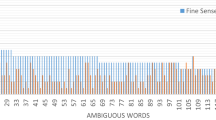Abstract
Natural language processing (NLP) refers to the ability of a computer program capacity to understand both spoken and written human languages. Word Sense Disambiguation (WSD) is a method for separating words with similar meanings and determining the words with the precise significance of meaning. It is an essential and critical application for all NLP tasks. Several methodological approaches come up in the context of WSD. There are supervised and unsupervised WSD approaches that are widely used in the disambiguation process. Supervised WSD approaches have shown better results than unsupervised approaches. The Naïve Bayesian (NB) classifiers approach is known as one of the best methods among all the supervised approaches for WSD. NB is a classification algorithm that is based on the Bayes theorem and it simplifies learning by accepting that features are independent of a given class. In this paper, we use an NB classifier to disambiguate ambiguous English words by predicting part-of-speech inclusive of “noun,” “verb,” “adverb,” and “adjective.” This disambiguation module is an enhancement in machine translation. The system reported the performance measure of eighty-five percent of the scale of F1-measure.
Access this chapter
Tax calculation will be finalised at checkout
Purchases are for personal use only
Similar content being viewed by others
References
Bahadur P, Chauhan DS (2014) Machine translation—a journey. In: 2014 science and information conference. IEEE, pp 187–195
Aung NTT, Soe KM, Thein NL (2011) A word sense disambiguation system using Naïve Bayesian algorithm for Myanmar language. Int J Sci Eng Res 2(9):1–7
Navigli R (2009) Word sense disambiguation: a survey. ACM Comput Surv (CSUR) 41(2):1–69
Zhou X, Han H (2005) Survey of word sense disambiguation approaches. In: Proceedings of the FLAIRS conference, pp 307–313
Al-Bayaty BFZ, Joshi S (2016) Comparative analysis between Naïve Bayes algorithm and decision tree to solve WSD using empirical approach. Lecture Notes Software Eng 4(1):82
Gupta R, Joshi N, Mathur I (2013) Quality estimation of English-Hindi
Ranjan Pal A, Saha D (2015) Word sense disambiguation: a survey. Int J Control Theor Comput Model 5(3):1–16. https://doi.org/10.5121/ijctcm.2015.5301
Le CA, Shimazu A (2004) High WSD accuracy using Naive Bayesian classifier with rich features. In: Proceedings of the 18th Pacific Asia conference on language, information and computation, pp 105–114
https://machinelearningmastery.com/gentle-introduction-bag-words-model/
Liu Y, Wang X, Wang L, Lv Z (2019) A Bayesian collocation method for static analysis of structures with unknown-but-bounded uncertainties. Comput Methods Appl Mech Eng 346:727–745
Pantel DLAP (2002) Discovering word senses from text. In: ACM
https://machinelearningmastery.com/bayes-theorem-for-machine-learning/
http://citeseerx.ist.psu.edu/viewdoc/download?doi=10.1.1.13.9418&rep=rep1&type=pdf
Pal AR, Saha D, Naskar SK et al (2021) In search of a suitablemethod for disambiguation of word senses in Bengali. Int J Speech Technol 24:439–454
Borah PP, Talukdar G, Baruah A (2019) WSD for assamese language. In: Kalita J, Balas V, Borah S, Pradhan R (eds) Recent developments in machine learning and data analytics. Advances in intelligent systems and computing, vol 740. Springer, Singapore. https://doi.org/10.1007/978-981-13-1280-9_11
Singh VP, Kumar P (2018) Naive Bayes classifier for word sense disambiguation of Punjabi language. Malaysian J Comput Sci 31(3)
Kumari S, Singh P (2013) Optimized word sense disambiguation in Hindi using genetic algorithm. Int J Res Comput Commun Technol 2(7):445–449
Sankar KS, Raj PR, Jayan V (2016) Unsupervised approach to word sense disambiguation in malayalam. Procedia Technol 24:1507–1513
Pal AR, Saha D, Naskar S, Dash NS (2015) Word sense disambiguation in Bengali: a lemmatized system increases the accuracy of the result. In: 2015 IEEE 2nd international conference on recent trends in information systems (ReTIS). IEEE, pp 342–346
Anand Kumar M, Rajendran S, Soman KP (2014) Tamil word sense disambiguation using support vector machines with rich features. Int J Appl Eng Res 9(20):7609–7620
Das A, Sarkar S (2013) Word sense disambiguation in Bengali applied to Bengali-Hindi machine translation. In: Proceedings of the 10th international conference on natural language processing (ICON). Noida, India
Kumar R, Khanna R (2011) Natural language engineering: the study of word sense disambiguation in Punjabi. Res Cell: Int J Eng Sci 1: 230–238. ISSN: 2229-6913
Haroon RP (2010) Malayalam word sense disambiguation. In: 2010 IEEE international conference on computational intelligence and computing research. IEEE, pp 1–4
Zelta EN (2014) Ambiguity. In: Stanford encyclopedia of philosophy. Retrieved from http://plato.stanford.edu; Navigli R (2009) Word sense disambiguation: a survey. ACM Comput Surv (CSUR) 10
Book “Natural Language Understanding” by James Allen, University of Rochester
Maurya AS, Bahadur P (2022) A detailed analysis of word sense disambiguation algorithms and approaches for indian languages. In: Proceedings
https://towardsdatascience.com/model-evaluation-i-precision-and-recall-166ddb257c7b
Acknowledgements
The authors would like to express their gratitude to the Council of Science and Technology, U.P, for proving fund under Adhoc-Research Scheme/Transfer of Technology Scheme with the reference no-CST/D 2475.
Author information
Authors and Affiliations
Corresponding author
Editor information
Editors and Affiliations
Rights and permissions
Copyright information
© 2023 The Author(s), under exclusive license to Springer Nature Singapore Pte Ltd.
About this paper
Cite this paper
Maurya, A.S., Bahadur, P., Garg, S. (2023). Approach Toward Word Sense Disambiguation for the English-To-Sanskrit Language Using Naïve Bayesian Classification. In: Khanna, A., Gupta, D., Kansal, V., Fortino, G., Hassanien, A.E. (eds) Proceedings of Third Doctoral Symposium on Computational Intelligence . Lecture Notes in Networks and Systems, vol 479. Springer, Singapore. https://doi.org/10.1007/978-981-19-3148-2_40
Download citation
DOI: https://doi.org/10.1007/978-981-19-3148-2_40
Published:
Publisher Name: Springer, Singapore
Print ISBN: 978-981-19-3147-5
Online ISBN: 978-981-19-3148-2
eBook Packages: Intelligent Technologies and RoboticsIntelligent Technologies and Robotics (R0)




